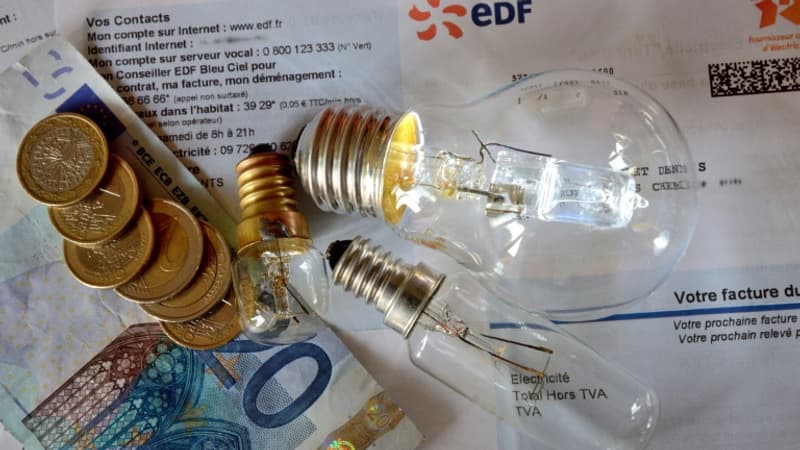Exceptional energy check, inflation compensation, price shield, fuel discount… The exceptional measures implemented by the government between January 2021 and June 2022 will not have been enough to offset the impact of the rise in fuel prices. energy in the purchasing power of the French. .
According to an INSEE note published this Monday, the disposable income of households in the period, after deducting energy costs, was on average 840 euros less than it would have been without a price rise. Integrating State aid (rate shield, fuel discount, energy check, etc.), the net loss is somewhat less significant: 720 euros on average, or a 1.3% reduction in purchasing power.
In detail, this drop in the standard of living is mainly due to the costs of heating and running the house (+460 euros per household between January 2021 and June 2022), then fuel costs (+380 euros), partially compensated, therefore, by a capital gain of 120 euros in aid.
Excess spending of 24,800 million euros
In the end, between January 2021 and June 2022, the global energy expenditure of the French will have been 24.8 billion euros higher than what it would have been if prices had remained at those of 2020. A result that, however, is not to take with caution. since it is expressed “for consumption without changes”, or because it is considered that households have not changed their purchasing behavior due to the rise in prices.
Despite the tariff shield, the rise in electricity, gas and fuel prices explains a large part of this additional spending (+13.6 billion). The rest (+7.6 billion related to diesel spending and +3.6 billion related to gasoline) comes from higher fuel prices.
State aid, for its part, has made it possible to increase the overall standard of living of households by approximately 3,500 million euros, of which 3,000 million only to compensate for inflation. Therefore, global household disposable income after energy expenditure remained €21.3 billion below what it would have been without price increases and without support measures.
240 euros of additional expenses per household without tariff shield
It must be said that the rise in energy prices was especially brutal. Between January 2021 and June 2022, gasoline and diesel prices were, respectively, 20% and 24% higher on average than in 2020. Fuel oil, for its part, gained 41%, compared to to +37% of gas and +5% of electricity. That’s an average increase across all energy prices of 18% over this period.
The tariff shield and the fuel discount, however, made it possible to limit the damage. Without these supports, household energy spending would have been 270 euros higher on average per household between January 2021 and June 2022 (+240 euros without escutcheon, +30 euros without pump discount).
Rural and low-income households first affected
In absolute value, the richest 10% is the one that has seen its standard of living drop the most in the face of the energy crisis, with an average loss of 1,230 euros. While households that are just above the median income only lose 770 euros and for the lowest 10%, 300 euros. On the other hand, given that energy expenditure represents a greater part of the budget of the poorest, low-income households are the ones that have suffered the greatest drop in the proportion of their income (-2.3% between January 2021 and June 2022 for the poorest 30). % versus -1.2% of the richest 30%.
Given these price increases, the poorest 30% benefited from an average of 170 euros in aid, that is, the equivalent of 0.7% of their disposable income, compared to 60 euros for the richest (0.1% ). But the price shield and the discount at the pumps that are intended to contain the rise in prices have benefited the 30% of the richest households the most, since they have reduced their spending by around 350 euros, compared to the 210 euro average of 30 % of the most modest.
Similarly, households living in rural areas -who spend more on diesel and heating oil to go to work- have seen their purchasing power fall more sharply than the rest with a loss of income linked to energy expenditure of 910 euros on average after payment of the aid between January 2021 and June 2022 (-1.7%), compared to a loss of 780 euros for residents of towns with fewer than 20,000 inhabitants (-1.6%), 650 euros in cities of 200,000 to 2 million inhabitants (-1.2%) and 580 euros for households in the Paris area (-0.8%).
Pickup in purchasing power in the second half of 2022
However, purchasing power should pick up in the second half of 2022, due to the increase in wages (revaluations, increase in the minimum wage), the payment of the shared value bonus, the revaluation of the index point of the civil service and social benefits approved in July, or even other support measures from the Government (increase in the fuel discount to 30 cents, suppression of the television fee, etc.).
All these are elements that should allow the purchasing power of the French to increase by 0.8 and 0.7% in the third and fourth quarters of 2022, after -1.8 and -0.7% in the first and second trimester.
Source: BFM TV


